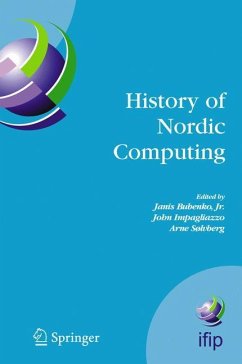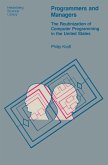This book is an essential reference for both academic and professional researchers in the field of historical computing. It is the first book in English that covers the early era of Nordic computing from the 1950s to the early 1980s. Most of the contributors are themselves pioneers in the field. The book deals with many aspects of Nordic computing such as the development of early computer hardware, development of basic software and compilers, design and implementation of early applications in engineering as well as in organizations and developments in use of computers in education. Other aspects described include Nordic cooperation in terms of conferences and journals as well as the role of computers in social life and in politics.
Paper topics include, among many others, themes such as the pioneering era in Norwegian scientific computing (1948 - 1962), the role of IBM in starting up computing in the Nordic countries, computers and politics, and Algol-Genius as an early success for high level language. Other topics include the birth of Simula, the Scandinavian school of information systems development, and the role of women in the pioneering years of Nordic computing.
This book is indispensable for teachers in computing in that it gives them an extended perspective on the topics they are teaching. It is also valuable for those interested in and working with historical analyses of Nordic computing. It contains original contributions from many pioneers of Nordic computing. These contributions form an excellent beginning to further historical investigations and analyses. The book also contains articles written by computer historians that make significant conclusions about decisions made regarding development of a computing industry in the Nordic countries.
Janis Bubenko, Jr. is professor emeritus of computer and systems science at the Royal Institute of Technology and Stockholm University, Sweden. John Impagliazzo is professor of computer science at Hofstra University in New York. Arne Sølvberg is professor of computer and information science at the Norwegian University of Science and Technology, Trondheim, Norway.
Computing in the Nordic countries started in late 1940s mainly as an engineering activity to build computing devices to perform mathematical calculations and assist mathematicians and engineers in scientific problem solving. The early computers of the Nordic countries emerged during the 1950s and had names like BARK, BESK, DASK, SMIL, SARA, ESKO, and NUSSE. Each of them became a nucleus in institutes and centres for mathematical computations programmed and used by highly qualified professionals. However, one should not forget the punched-card machine technology at this time that had existed for several decades. In addition, we have a Nordic name, namely Frederik Rosing Bull, contributing to the fundaments of punched card technology and forming the French company Bull. Commercial products such as FACIT EDB and SAAB D20-series computers in Sweden, the Danish GIER computer, the Nokia MIKKO computer in Finland, as well as the computers of Norsk Data in Norway followed the early computers. In many cases, however, companies and institutions did not further develop or exploit Nordic computing hardware, even though it exhibited technical advantages. Consequently, in the 1970s, US computers, primarily from IBM, flooded the Nordic market.
Paper topics include, among many others, themes such as the pioneering era in Norwegian scientific computing (1948 - 1962), the role of IBM in starting up computing in the Nordic countries, computers and politics, and Algol-Genius as an early success for high level language. Other topics include the birth of Simula, the Scandinavian school of information systems development, and the role of women in the pioneering years of Nordic computing.
This book is indispensable for teachers in computing in that it gives them an extended perspective on the topics they are teaching. It is also valuable for those interested in and working with historical analyses of Nordic computing. It contains original contributions from many pioneers of Nordic computing. These contributions form an excellent beginning to further historical investigations and analyses. The book also contains articles written by computer historians that make significant conclusions about decisions made regarding development of a computing industry in the Nordic countries.
Janis Bubenko, Jr. is professor emeritus of computer and systems science at the Royal Institute of Technology and Stockholm University, Sweden. John Impagliazzo is professor of computer science at Hofstra University in New York. Arne Sølvberg is professor of computer and information science at the Norwegian University of Science and Technology, Trondheim, Norway.
Computing in the Nordic countries started in late 1940s mainly as an engineering activity to build computing devices to perform mathematical calculations and assist mathematicians and engineers in scientific problem solving. The early computers of the Nordic countries emerged during the 1950s and had names like BARK, BESK, DASK, SMIL, SARA, ESKO, and NUSSE. Each of them became a nucleus in institutes and centres for mathematical computations programmed and used by highly qualified professionals. However, one should not forget the punched-card machine technology at this time that had existed for several decades. In addition, we have a Nordic name, namely Frederik Rosing Bull, contributing to the fundaments of punched card technology and forming the French company Bull. Commercial products such as FACIT EDB and SAAB D20-series computers in Sweden, the Danish GIER computer, the Nokia MIKKO computer in Finland, as well as the computers of Norsk Data in Norway followed the early computers. In many cases, however, companies and institutions did not further develop or exploit Nordic computing hardware, even though it exhibited technical advantages. Consequently, in the 1970s, US computers, primarily from IBM, flooded the Nordic market.








